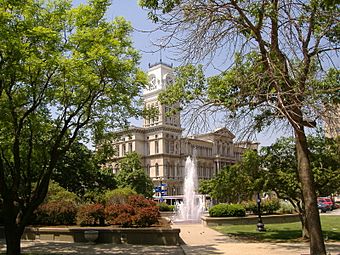Louisville City Hall facts for kids
Quick facts for kids |
|
|
Louisville City Hall Complex
|
|
 |
|
| Location | Louisville, Kentucky |
|---|---|
| Built | 1873 |
| Architect | Multiple |
| Architectural style | Beaux Arts Second Empire< Romanesque Revival |
| NRHP reference No. | 76000905 |
| Added to NRHP | September 1, 1976 |
Louisville City Hall is a really old and important building in Louisville, Kentucky. It was finished in 1873. This historic building is where the city government used to work. It was added to the National Register of Historic Places in 1976.
Today, Louisville City Hall is mainly where the Louisville Metro Council meets. The council members make important decisions for the city. The mayor's office is in a different building nearby, called Louisville Metro Hall.
Contents
A Look Back: History of City Hall
Where Government Began
The spot where City Hall stands has always been important for Louisville. Long ago, in 1784, the first courthouse was built across the street. Later, a brick courthouse stood on this very site from 1811 to 1837. Before City Hall was built, city leaders shared space in the county courthouses. There wasn't a special building just for the city government.
Designing a New Home
In 1867, the city decided to build its own special building. They held a contest to find the best design! The winner received $500. A local architect named John Andrewartha and C.S. Mergell won the contest in April 1867.
In 1870, the final plans for City Hall were made by Andrewartha. He was named the main architect for the project. Other old government buildings were taken down before construction started in 1870. I.M. St. John, the city engineer, was chosen to watch over the building project.
Building the Hall
The building was made using Indiana Limestone. This stone came from quarries near Salem, Indiana. Construction took place between 1870 and 1873. The final cost was about $464,778.
The outside of City Hall has been updated several times. But it still looks mostly the same as it did long ago. The inside, however, has been completely changed many times over the years.
Growing the Complex
In 1909, a new building was added just west of City Hall. It was designed by Cornelius Curtin. This building had a Greco-Roman style.
Later, in 1937, an old firehouse from 1891 was also made part of the City Hall complex. This building was used by the city's tax collectors. It quickly became known as the "Sinking Fund Building." All three buildings were added to the National Register of Historic Places as the City Hall Complex in 1976.
Architecture: What City Hall Looks Like
Louisville City Hall shows a mix of two popular building styles from its time. These are the Italianate and Second Empire styles. Both styles were often used for important public buildings.
Symbols of Progress
The designs on the building show how hopeful the city felt after the American Civil War. Over the main entrance, there's a special carving called a pediment. It shows the city's seal. It also has a train moving forward past plants from the South. The words "Progress, 1871" are carved there too.
Other carvings are found above the side windows. These carvings show heads of farm animals. This reminds us how important farming was in Louisville's early days.
The Clock Tower
The building has three full floors and a raised basement. The most noticeable part of City Hall is its tall clock tower. It stands 195 feet high! The tower has four clock faces. It also has a special roof called a mansard roof. The tower was not finished until 1876 because an earlier one burned down in 1875.
The tower once held a huge, three-ton bell. This bell rang until 1964, when the clock stopped working. It was fixed in 1968, but then broke again in the 1970s. The clock was finally repaired again in 1991.
Gallery




